By David Brownnell
(Editor’s note: The author served with HQ US 1st Logistics Command, 1st Logistics Message Center/Classified Document Repository during his tour in Vietnam 1969/1970. He handled virtually all US Army message traffic regarding logistics including the supply and maintenance of weapons for US and, to an extent, each of the Allied forces in Vietnam. This report is a rare insight into the armament supply problems that plagued all combatants during that time.)
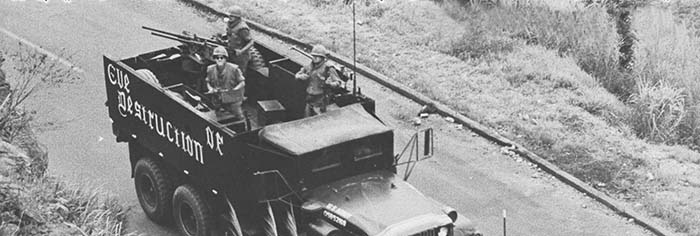
To supplement available supply stocks of modern US weapons in the Vietnam Theater of Operations, the four US Army Transportation Groups in the four Corps Zone areas each ran a USARV-authorized “Operation Self-Help,” which refurbished weapons from battlefield salvage for use as additional arms above US standard Table of Organization and Equipment (TO&E) levels. They rebuilt from battlefield salvage significant numbers of M16-series rifles, M60 machine guns, .50 caliber M2 HB heavy machine guns with custom mounts, and M79 40mm grenade launchers, as well as the occasional aircraft-model machine gun and even 7.62mm Minigun. These extra weapons were primarily for Transportation truck units’ guntrucks and ordinary truck crews. This was the only source available to these units of the “over TO&E” weapons used to adequately equip the truck convoys and their covering guntruck crews; and the same program also supplied useful numbers of extra small arms over their official TOE authorizations to USARV MPs and Aviation units.
This was a major and well-organized workshop operation of the sort normally found stateside at the depot level, largely taken from Transportation group assets with the further assignment of a very small number of small arms technicians from the supporting corps area Logistics Support Commands, organized as one small arms workshop in each Transportation Group supporting the US Field Force to which that Group was assigned. Additional personnel from the group HQ company and Transportation battalions assisted at various times, primarily as labor details and individual volunteers under supervision for cleaning, sorting and packing. Other than this specially authorized salvage rebuild operation, official DOD policy at the time was that salvaged weapons needing more than ordinary maintenance by unit armorers were to be “retrograded” back to the US for depot maintenance.
This “Self-Help” program was originally authorized during 1967 to generate extra weapons by the Transportation units’ own efforts as needed for intense convoy protection operations, and under “command interest” by General Westmoreland, and then General Abrams, was still continuing in 1970 despite objections from high levels at Department of Defense. The Transportation units, and 1st Log’s supply and arms maintenance people, correctly pointed out that the flow of replacement weapons in the US supply pipeline to USARV was just about sufficient to maintain US line combat units during the intense operations experienced during 1968 and 1969, but were not sufficient to also supply the truck units nor the MPs with the extra weapons above normal TO&E needed for convoy protection during this period. General Westmoreland and then General Abrams both endorsed this unit rebuild operation, and insisted that it be continued unless and until greater numbers of weapons could be supplied.
The bottleneck for the Transportation Group armorers was in replacement parts and rebuild kits for the M16-series rifles, as “the service units in Vietnam were not authorized this weapon.” (Officially, the authorized rifle for all service support units was the 7.62mm M14 Rifle, supported in these units by relatively small numbers of machine guns and of M79 grenade launchers.) It took repeated “command interest messages” during late 1969 and early 1970 by both the MGen commanding 1st Log Command, and by Gen. Abrams himself, to finally kick loose from stateside some additional maintenance parts and some small batches of the M16 rebuild kits for the continuing “Operation Self-Help.”
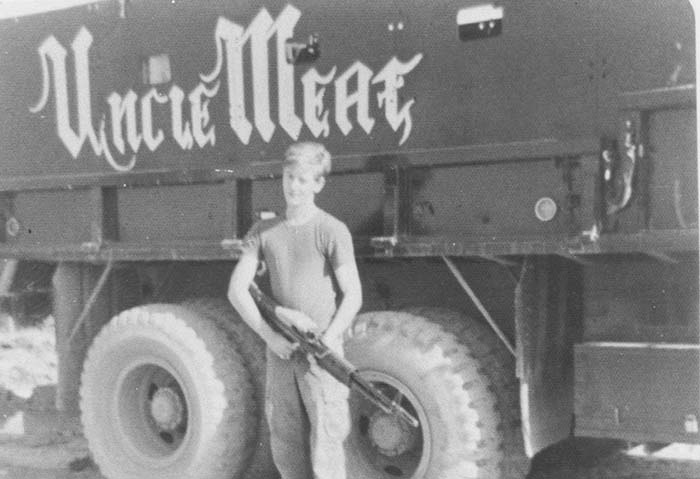
Sufficient numbers of both ordinary critical repair parts and the “official” upgrade rebuild parts kits for the worn-out early M16 rifles were never available in sufficient supply to the Transportation Groups. Thus, a certain amount of local experimentation was done by these Self-Help workshops in polishing out moderately pitted chambers, repairing or locally fabricating a small number of certain critical parts, and even cleaning and retempering springs. (This last did not work reliably: the retempered old springs tended to be more brittle, but new springs were never available in the numbers required.)
Lacking chromed barrels for rebuilding, Transportation Group Operation Self-Help armorers during 1969 experimented by selecting lightly to moderately corroded M16 barrels with “tight” chamber tolerances, and then brought them to maximum “loose” dimensional tolerance while smoothing the pitting by lapping and polishing the chamber. (One operation that I saw in II FF used a modified brake drum lathe fitted with a shop-turned chamber lap, in order to mechanize this procedure.) A few of these rebuilt M16 weapons that I saw in trucker hands obviously ended up with chambers lapped out over-tolerance; these produced some expanded-near-the-case-head funny-looking fired cases, but still operated. Other rebuilt M16s polished out in this way ejected near-perfect cases.
Another unit experiment by Transportation armorers, finally abandoned upon direct orders from stateside, had explored the rebuilding of original Edgewater Spring buffers by opening the unit, variously pouring lead into a drilled hole for added mass, or adding various combinations of weights and rubber or nylon washers in an attempt to approximate the improved Colt buffer. The armorer then reassembled the separated unit in various ways (brazing, and cutting and threading two original buffers to screw together as one modified buffer, were among several methods tried).
In addition to the rebuilding of standard machine guns and M16-series rifles, a number of custom M14 auto rifles and chopped M60s were turned out as “bailout” and high-fire capacity close combat weapons for truck and guntruck crews. Even a few cut down M16s were built up from otherwise damaged weapons. M16 barrels with damage near the muzzle were shortened despite the “slam-bam” more abrupt pressure curve of the shortened tube. For better reliability, the new improved buffer was fitted to these experimental do-it-yourself M16 carbines.
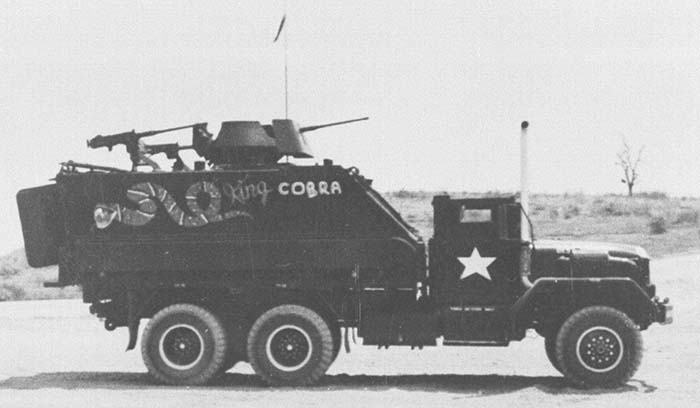
In Vietnam, Weapon Collection Points were designated for units to turn in weapons salvaged from the battlefield. Here, the weapons turned in were sorted into piles of US and enemy types, rifles separated from machine guns, and heavy weapons set aside in another pile. Acquisition teams from the Transportation Groups, along with other authorized teams from Special Forces and from ARVN units, then would cherry-pick weapons which seemed to be salvageable. Once selected by the Transportation Group teams from the weapon collection points, these battlefield salvage weapons were taken to Transportation Group workshops to be stripped down, cleaned and inspected, then repaired or rebuilt as necessary. Unrepairable pieces were parted out for useable spares.
ARVN units also operated their own weapons salvage and rebuild programs. With the assistance of their US advisors, during late 1968 through 1970, they largely equipped their divisional reconnaissance and commando assault units with salvaged modern US small arms, alongside significant numbers of captured AKs and RPDs.
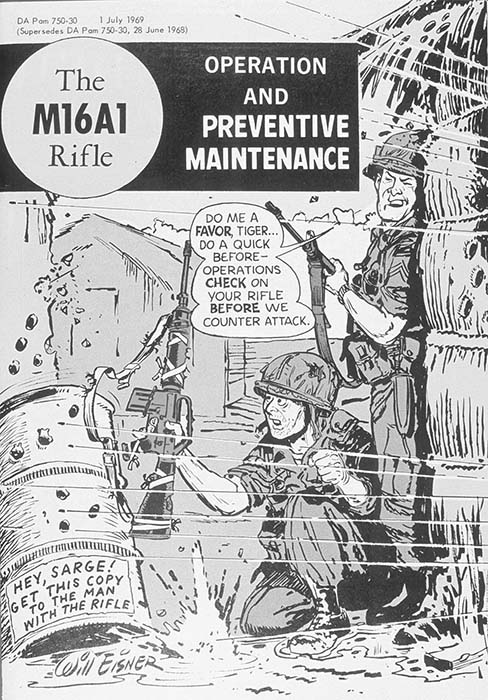
Return Shipment of Damaged Weapons to the US:
Unit packing of damaged weapons being retrograded to US stateside depots could be very rough-and-ready with some of the returning weapons having been hurriedly packed up for shipment. A plaintive message of complaint from a depot in Hawaii was perhaps typical: It mentioned finding shipping containers full of weapons and other items returned by combat units with no manifest at all; some weapons which had been shipped chamber loaded, cocked and safety off, many of these with dried mud in the bore; captured SovBloc weapons mixed in without manifest along with the US weapons, including some unusual or new items of interest to Military Intelligence; weapons along with loose ammo including grenades and mortar rounds thrown willy-nilly into a CONEX container without packing, and yet other CONEX containers stuffed with loose weapons, and then filled up with expanding plastic foam (then required to be tediously chipped apart by the receiving depot).
Captured Weapons:
Captured AK-47s had earlier been carried by some US riflemen or grenadiers, especially during 1966-1967 when some US units had such troubles with their early model M16 rifles. By 1968, aside from MACV-SOG and the LRRP units (who used a few AKs and RPDs during semi-covert patrols of the border areas and into Laos), and the occasional AK-47 carried on a turret top or as a sturdy supplemental emergency weapon by a “Bloop” gunner or dissatisfied M16 rifleman, US forces in Vietnam officially discouraged the use of captured SovBloc automatic weapons in combat. One reason was the characteristic sound of the enemy weapons, and their usual green, white or pink tracers. Especially at night, this was discouraged by experienced troop commanders, as either signature would draw heavy US fire, even more especially when US fighter bombers, gunships or attack helicopters were operating in the area. A gunship or fighter pilot, seeing characteristic enemy tracers in a ground action below, was likely to follow the tracer line back to its source as a target.
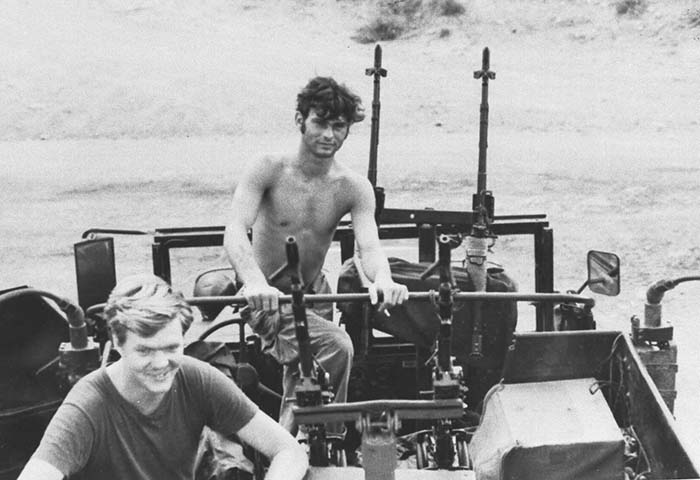
In early 1970, a firm final order (No discussion is desired!) came down over General Abrams’ signature: All captured enemy 7.62x39mm weapons, and all SovBloc machine guns, now were prohibited from use by US troops (except for certain recon elements on “Road Runner” operations), and all captured/salvaged weapons along with mortars and RPGs were to be immediately turned in. Besides the considerable friendly fire hazard of misidentifying US troop use of a captured automatic weapon, the newly independent Lon Nol Cambodian government under US blandishment had now declared against the VC and North Vietnamese. Cambodia already largely used the Soviet arms family, acquired as a 10% “transfer tax” from shipments through the port of Sihanoukville intended for the VC in Vietnam’s Delta region. They now needed additional weapons in a hurry so that they could urgently expand their small national Army and other security forces in an attempt to guard against further occupation of the Cambodian border region by the VC and NVA. Any SovBloc weapons that we could supply to Cambodia from captures in Vietnam would help, and that was to be the directed destination of all further salvaged AKs, RPGs and Soviet-pattern machine guns.
By 1970 the great majority of captured communist-made small arms in Vietnam (my recollection is some 80% of captures during the last half of 1969) actually were Chinese or occasionally Korean in origin, whereas in 1963-1965 about half of the small arms to the VC were then supplied by the USSR from Soviet production, with small quantities from virtually all of the Warsaw Pact states, and the other half a mixture of the new 7.62x39mm generation from China along with older Chinese equipment.
Individual Maintenance of the M16 Series Rifles in Vietnam
By March, 1969 when I received M16 familiarization training prior to my deployment to Vietnam, US Army policy on the M16 rifle had changed 180 degrees from the early “no cleaning needed” approach. We were carefully instructed in basic field stripping and daily cleaning of the M16 rifle, and advised to keep a toothbrush on your person for this purpose. Specifics of dealing with caked heavy fouling was not addressed, but was at least mentioned as a problem. During a break, one of the committee sergeants did pass on his own experiences in using Dri-Slide as a palliative when the chrome plating on the bolt slide began to wear and to gall the mating surfaces. Use of the Bolt Forward Assist was explained, but with the observation that the only effective measure of dealing with a case stuck in the chamber was to punch the jammed case out using a .223 sized cleaning rod.
After the three days of M16 familiarization training, my knowledge of cleaning and maintenance of the M16 was adequate for what was expected in my job as a REMF, should I have been in a unit where the clerks carried M16s. I still would have had to learn the hard way how to keep the rifle going during extended combat operations out in the field.
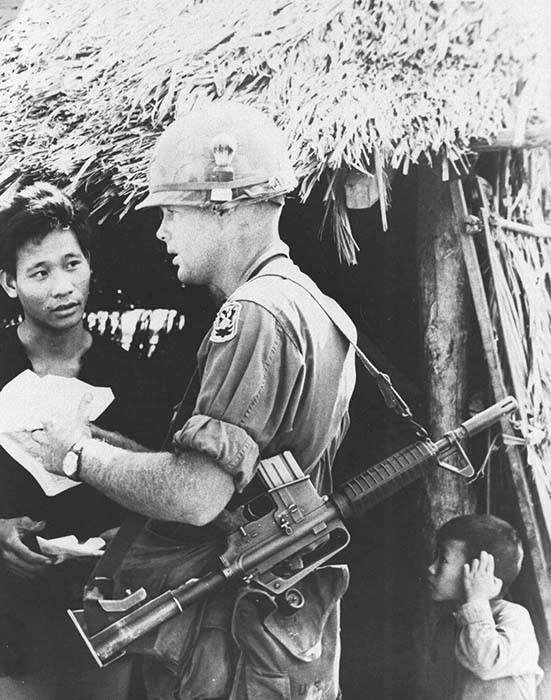
M16 Rifle Reliability Problems in Vietnam
The standard US Army gun oil intended for the M14 and other 7.62mm weapons was not suitable for the M16, and certainly was not an effective cure for M16 rifles which had worn through their chrome bolt plating to scrub off the internal dry lubricant. Standard US Army gun oil caked badly when exposed to the gas residue of the 5.56mm’s ball powder, and even more so in the presence of high humidity. The standard Army bore cleaner also was not an effective solvent for removing this stubborn carbonate fouling. Some US soldiers in Vietnam personally ordered commercial gun cleaning solvents intended for heavy fouling, and Dri-Slide or other molybdenum dry lubricant, from family or from mail order suppliers.
Despite the problems experienced by Army and USMC units in Vietnam with worn or corroded M16 rifles during 1966-1967, the USAF in contrast had no appreciable difficulties that I am aware of in using the original AR-15/M16 rifle in Vietnam, despite the heavy ball powder fouling, and the fact that their AR-15s also had the early form of buffer. They had emphasized proper cleaning and maintenance of the AR-15 from the outset, buying appropriate commercial products while the Army still dithered on the question of officially authorized cleaning materials for the M16. The USAF rifles introduced the chromed chamber quite early in production, and quickly went to the improved buffers as maintenance replacement items for their earlier rifles as soon as these improvements were introduced in new USAF production. Admittedly, the Air Force’s AR-15/M16 rifles, even in the USAF Base Defense Squadrons, received less intense usage and more cleaning than did those of Army infantry units as USAF weapons served with fewer long-duration patrols, and less time without cleaning in a salt-marsh environment such as numbers of Army units encountered. And, it is interesting, that the USAF never found it desirable to introduce the Bolt Forward Assist to their version of the M16.
When I had the opportunity in Vietnam during 1969 to compare the original USAF smooth-side bolt carrier side-by-side with the original Army chromed smooth-side bolt carrier, I noticed a number of subtle differences in shape. Possibly, these differences may have represented merely different production generations. Judged merely by estimated heft, the USAF bolt seemed slightly more massive. If so, this would have tended to bring down the high cyclic rate a bit.
The US Marines also made sure to order effective cleaning supplies, and as with any Marine weapon, they meticulously maintained their M16s. The severe M16 jamming problems which some USMC battalions experienced after changing over to the M16 while in Vietnam, I think, is due at least partly to the fact that to supply the numbers of M16s in a hurry, the initially issued USMC stocks of this weapon were largely used ex-Army rifles, some from Army holdings already in Vietnam and others were weapons returned to Army depot inventory after extensive stateside field testing during the M16 trials and/or the 11th Air Cavalry extensive proof-of-concept field exercises (with much firing of blank rounds and little, if any, cleaning), or after heavy use in training establishments. Continuing operations in a salt marsh environment aggravated corrosion problems of these used rifles, and to a lesser extent of new M16 rifles issued to the Marines at the same time. The unchromed chambers of the early M16 production pitted very easily.
Non-Supply of Army “Official” M16 Cleaning Items
During 1969, and at least until I left Vietnam at the end of March 1970, HQ 1st Log, HQ USARV, and many Army individual combat and support units, were still in constant correspondence with stateside authorities trying to arrange for regular supply of proper cleaning supplies (caliber .223/5.56mm cleaning rods, patches, proper cleaning solvent and dry lubricant suitable to the M16). Despite an official 1967 start of large scale distribution to troops of M16-specific cleaning materials, these still during 1969-1970 were almost impossible to obtain through official sources for any units in Vietnam save Infantry (and in early 1970 were still in short supply even for these combat units). Return messages from stateside were almost uniformly unhelpful even in early 1970, variously stating for example that “testing of cleaning equipment, of lubricant and of solvent agents for the 5.56mm weapon were not yet complete,” that “quantities of authorized cleaning materials available for shipment were not yet in the supply pipeline” (and hence could not be shipped – in 1970!), that “untested commercial cleaning supply items for caliber .223 were NOT authorized for government issue, nor for purchase with official unit funds,” as well as a host of other reasons why requisitions for such cleaning supplies could not, as yet, be filled. This despite the existence of official item numbers in the stock guide: Oh, no, “Those were older interim types, no longer readily available.”
Judging by unofficial comments from troops in the field, as well as official correspondence which passed across my desk during this period, most US Army units in Vietnam as late as early 1970 still were cutting standard caliber 7.62mm cleaning patches into quarters for use in the smaller 5.56 mm bore, and were using personal funds as well as “unit recreation funding” to irregularly purchase commercial .223 cleaning rods and brushes intended for varmint rifles (one-piece rods as well as sectional rods), various proprietary commercial bore solvents, and molybdenum dry lubricants such as Dri-Slide. Individual troops also were asking family members to ship these commercial items to them via personal mail.
Parts for M16 Rifle Series Maintenance and Rebuilding:
A parallel problem was the continuing difficulty of obtaining adequate numbers of M16 and M16A1 maintenance parts by many US units in Vietnam, as well as the limited numbers of rebuild kits available for the earlier model M16. These requisitions went through the same stateside offices for approval as for the requested M16 cleaning supplies. The M16A1 had become the official standard light rifle for the Vietnam Theater of Operations in 1967 and had entered widespread distribution in 1968. However, although many original M16 rifles had been passed on to the ARVN, or returned to the US for training, most units already in Vietnam still had some of the original M16 version on hand in 1969. A significant percentage of the rebuilt battlefield salvage M16s used by the Transportation Groups in Vietnam were the earlier version.
Replacement barrels with chrome chambers were in extremely short supply in Vietnam, and there were some other critical shortage item maintenance parts for the M16-series rifles, especially the buffer, disconnector, and bolt latch. Official DOD policy was to ship weapons deadlined for corroded chambers back stateside for depot-level rebuilding. Although the M16A1’s chromed barrel could be interchanged into the earlier M16, this was specifically prohibited to units in Vietnam, as the improved barrels in early 1970 were still in short supply and reserved for repair of the -A1 version. Infantry unit armorers at battalion level in Vietnam did perform a fair number of barrel changes to the new chrome barrel on pitted M16A1 rifles, as well as rebuilding some older M16s to the new standard with original pattern of barrel, improved buffer, disconnector, new bolt latch and new bolt carrier. It was an unfortunate choice, made at DOD level, not to routinely replace the unchromed early barrels with the new chromed-chamber version, but rather to replace these only on an “as needed” basis, and to continue use of the stock of old unchromed barrels already in the supply line. Experience of the Marines, and of Army troops also operating in salt marsh or littoral areas in Vietnam, is that the unchromed chambers of even brand-new barrels would quickly pit through corrosion when carried daily in such conditions.
At the start of 1970, US Army Infantry units and recon units (LRRPs) in Vietnam had priority on the available M16-series maintenance parts. It was the MPs, Army Aviation, and the Transportation truck battalions who were left relatively unsupported on the question of M16 maintenance parts, as well as left without M16-specific cleaning parts. Officially, said one message from stateside, this shortage of repair parts and of cleaning items was due to necessary allocation of items in short supply, and also due to further ongoing testing of both improvements to the M16-series weapon, and of “cleaning supplies proper to its unique design and materials.”
M16 Magazine Flaws
Some M16 magazines were inherently unreliable: The aluminum body of magazines in the soldier’s web pouch could easily be dented when hitting pavement or rocky ground, some magazines more easily than others. The feed lips of the aluminum magazine sometimes were too soft to retain their shape, resulting in failures to feed. Others were too soft in the area of the notch for the magazine catch. With wear, extra play here allowed the magazine to drop down slightly and gave a bad feed. By 1969, the answer in most units was to simply replace the soft magazine with a better one, and to either smash or cut the bad magazine so that it could not be reissued. (Many unit armorers kept a large pair of bolt cutters on hand for this purpose). Unfortunately, in some units an attempt was made to reshape feed lips by hand, or the bad magazine was simply cleaned and put back into stock to repeat the problem in the future.
Defective 5.56mm Ammunition
One further problem was the question of defective ammunition lots. We in Vietnam had several 5.56mm ammunition lots identified by units or turned in as defective as late as 1968 and 1969. Some had soft rims and were prone to let the extractor tear through the rim (this was especially likely when fired in a corroded chamber). Other 5.56mm ammo lots appeared not to have been properly annealed; the case was fully shiny rather than showing the annealing discoloration common to all military ammunition. These sometimes would separate when extracted, leaving the neck, or neck and upper case body, stuck in the chamber. In badly corroded chambers of individual rifles, headspace tolerances also could have worsened such a problem. However, repeated unit testing by many units established that the soft rim and case separation problems were associated with particular ammunition lots. The problem did not appear in other batch lots made to standard Milspec in the same test weapons.
Growing frustrated with continuing refusals by stateside to authorize withdrawal of the affected ammunition lots from the Vietnam Theater of Operations, most of the suspect ammo was finally marked on USARV authority as “Training Only.” Unfortunately, some of this was then given to the ARVN forces. Other quantities of these suspect ammo lots were destroyed as “damaged ordnance” during 1968/69 after major fires at both the Saigon and Qui Nhon ammunition dumps. Additional to the munitions actually damaged in the blaze, these bad ammo lots were declared on paper as damaged, and then destroyed by EOD teams along with other defective, damaged and dangerous munitions during the after-fire cleanup.
ARVN and Allied Maintenance of the M16 Rifle
Regarding maintenance parts for the M16, the Government of Vietnam was in even worse shape than US Army support units: They had received small numbers of early M16 rifles in a demonstration program as early as 1965, with accelerating numbers transferred to them after Tet of 1968. Initially, these went largely to ARVN Airborne and some Ranger units, but by mid-1969 a number of ARVN divisional line infantry units had rearmed with at least some M16s. Meanwhile they also had picked up substantial numbers of repairable M16s, M14 rifles, and M60 machine guns as battlefield salvage, along with AKs and RPDs.
Unfortunately, only very limited supplies of maintenance parts were supplied to the Vietnamese Government by the US within the Foreign Military Sales (FMS) program. For various reasons, the official US policy was to provide to the Government of Vietnam under FMS credits only limited numbers of rebuild kits and maintenance parts for early M16 rifles, capped at the numbers of early weapons officially issued to the Government of Vietnam. The Vietnamese government bought some limited additional quantities of M16 repair parts directly from Colt for cash, but with very limited foreign exchange (actually, negative reserves), they were only able to purchase a few hundreds of critical repair items in this manner.
In contrast, Australian, Thai and Republic of Korea troops in Vietnam seemed to be well supplied with repair parts for their M16A1 rifles, and were fairly happy with the handy little weapon. The Australians used the M16A1 in relatively small proportions; more as a replacement for the 9mm submachine gun in infantry companies and reconnaissance elements, and for M113 APC crew, than for their 7.62mm L1A1 SLR rifles. They made direct commercial purchase of the M16A1 from Colt, and usually purchased their repair and maintenance items in the same way except for small emergency issues from the US Army Saigon Support Command depot. US official supplies of repair and rebuild parts for the M16-series rifles to Thai and Korean forces in Vietnam seemed more freely available than to US units. Certainly we filled their requisitions promptly and in full. This would not always be the case for US Army units.
Save for Thai-specific supplies such as rations, uniforms and some non-US equipment, the US had a commitment to Thailand to provide full logistic support to Thai troops in Vietnam. As a condition of deploying this division-sized Thai force to Vietnam, the Thai Expeditionary Force was fully equipped with the current range of standard US equipment (including both M16 and M16A1 rifles as their standard infantry weapon). We supplied them with repair parts and limited numbers of M16A1 rebuild kits under this agreement at least to the same standard or better as for US infantry units. However, the most common practice during 1969-70 in Vietnam with deadlined Thai M16-series rifles was for the US to exchange worn-out or damaged Thai M16s as direct exchange, turning in and exchanging periodic batches at US Saigon Support Command depots at Long Binh.
The ROK forces in Vietnam arrived in-country with US World War II vintage generation .30 caliber weapons, and continued to use these as their basic weapons family into 1968. After Tet of 1968, however, we supplied to the ROK increasing numbers of both M14 and M16A1 rifles, along with M60 machine guns and M79 grenade launchers. ROK forces from 1968 to early 1970 seemed to use their M16 rifles mainly among recon troops and M113 APC crews. Although they also used some M16 rifles among their line infantry companies, they preferred the M14 rifle instead (with its heavier 7.62mm punch) to gradually replace the older ex-US M1 rifles and BARs in ROK rifle units. As did the ARVN, the ROK forces also acquired substantial numbers of repairable modern US weapons from battlefield salvage. During their operations along Highway 1, they recovered a significant number of ex-US and ex-ARVN weapons from the VC and NVA, especially following the bitter fighting during and for the 18 months after Tet 1968. We did supply the ROK with proportionately fairly large amounts of M16-series repair parts and rebuild kits. As did our own Transportation units, the ROKs operated their own weapons rebuild program while in Vietnam, and salvaged significant numbers of weapons.
Along with the first two US Marine battalions to convert to the M16 in late 1965 while in Vietnam, the US Army’s 1st Air Cavalry Division and 196th Light Infantry Brigades had exceptional trouble with the early M16: this included heavy fouling, corroded chambers with resulting extraction problems, worn bolt plating, broken bolt latch, broken disconnectors, and corrosion of the receiver body especially around the magazine housing. It did not help that these units’ receipt of the weapon was before the beginnings of regular issue of proper cleaning supplies, during the period when some Army authorities still were recommending that “the M16 Rifle did not need regular cleaning.”
I was assigned as a special project to dig through back message files in order to trace what I could of weapon serial number blocks issued to these units, and then compare them with messages detailing major unreliability problems. I found that apparently the Air Cav and the 196th Light Infantry Brigade both ended up with fairly large numbers of early M16 rifles originally used in the intensive 11th Airmobile Division proof-of-concept trials back in the States, and in Vietnam the Air Cav found themselves saddled with significant numbers of early M16 rifles which “had been rode hard and put away wet.” Likewise, among the M16 rifles shipped to Vietnam to rearm the Marine battalions were numbers of early M16 rifles from the M16 unit field trials, pulled from Army depots and from training bases and shipped in a hurry to make up the numbers. Among defective weapons reported by serial number by these units were numerous weapons from the serial blocks used for the various intensive trials programs mentioned above.
The 1st Air Cav had some of these used M16s early in their Vietnam tour, the 173rd Airborne Brigade also got some when it converted from the M14 Rifle to the M16, and the 196th Light Infantry Brigade (which later became part of the Americal) received numbers of used M16s when they were initially stood up and trained for deployment to Vietnam. On the other hand, the specially formed 11th Armored Cavalry Regiment had much less trouble with the M16 during the same period, being largely armed with new, never before issued M16s. Their lower incidence of trouble, however, may partly have been because of better rifle maintenance in their unit culture than among the Air Cav and Light Infantry, and perhaps also because of the 11th ACR’s lesser exposure to a salt environment than the light infantry units.
XM177E1 Carbine: Perception of Reliability
Despite the short barrel with its sharp pressure curve and resulting abrupt firing cycle, and despite later testing showing a similar rate of operating failures to that of the early M16A1 and actually not as good as the improved chromed barrel M16A1 that was starting to come along into the supply pipeline in late 1969, the relatively new XM177E1 carbine during 1969 was perceived among US troops in Vietnam as being much more reliable than the standard issue M16 and unchromed M16A1. In part this was due to all of this carbine issue having been manufactured with the chromed chamber, new bolt latch, new disconnector, and improved buffer as standard.
Since most of these non-standard carbines were issued to either reconnaissance units such as LRRPs (who generally were fanatical about weapons maintenance) or to combat officers, I suspect that better-than-average daily cleaning also played a role. Another factor is that in either role, the little carbine was seldom subjected to the routine daily protective “Mad Minute” on the unit perimeter that the ordinary rifleman’s M16 experienced, with its long bursts of automatic fire. Instead, the XM177E1 users tended to fire it in controlled bursts or on semiautomatic. The exception, of course, was when a small unit such as a recon team needed to break contact. But, that sort of heavy auto firing still was not done daily, so the recon team’s XM177E1 when badly needed usually had not been as worn and fouled by routine firing as the infantry rifleman’s M16 rifle.
| This article first appeared in Small Arms Review V10N1 (October 2006) |











